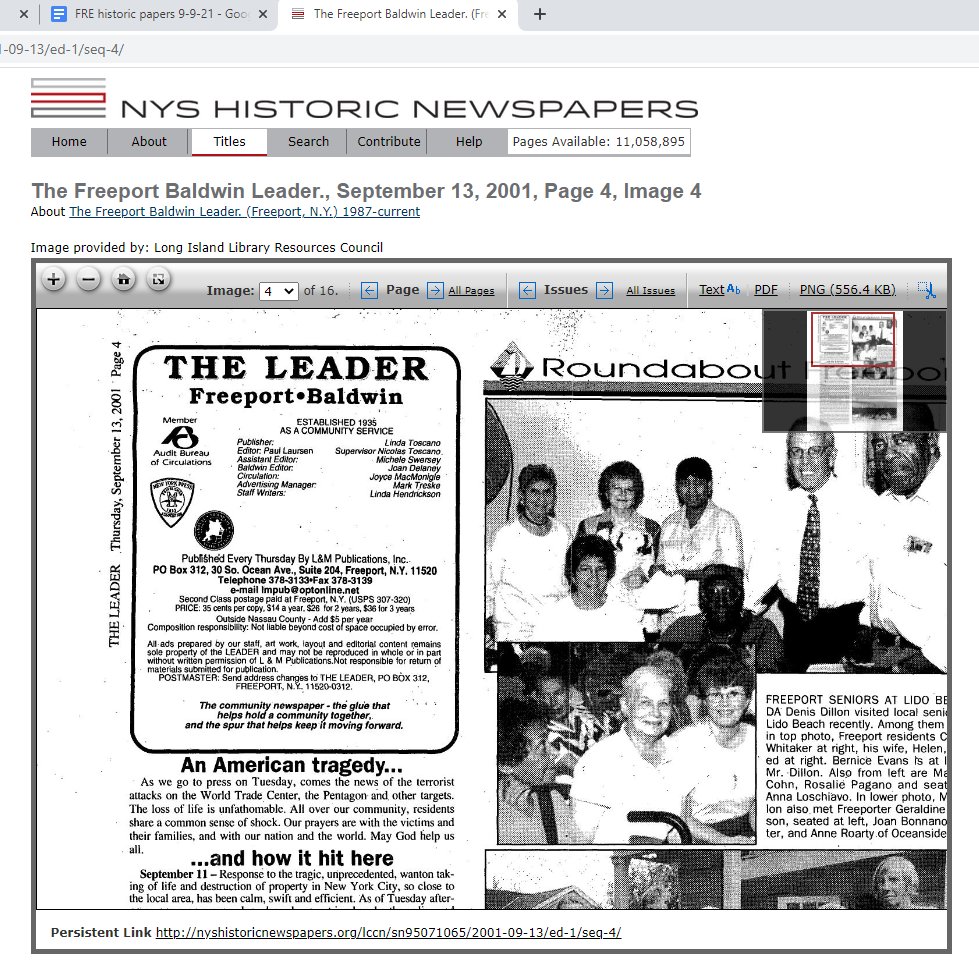Historic jewels await discovery at the Freeport Memorial Library
Remembering 9/11 is painful, yet part of healing is remembering. But how accurately do we recall a momentous event? To what source can we turn?
One place to go is the Freeport Memorial Library’s website, freeportlibrary.info. Scroll down the menu on the left and click “Freeport History.” The page that comes up presents no less than 26 buttons, each of which constitutes a portal to a different aspect of Freeport’s complex and colorful past. Village Historian Cynthis Krieg’s introduction, “The Freeport Story,” imparts an overview of the village’s progression from a small fishing outpost in the 1650s to a diverse community of more than 43,000 inhabitants.
The button most relevant to remembering 9/11 is “Local Newspapers,” which takes the reader to the digitized issues of The Leader. The Leader first imparted the news of the disaster with a half-column on page 4 of the Thursday, Sept. 13 issue. The Twin Towers were falling even as that issue was going into production on Tuesday, Sept. 11.
Recorded in that issue are the horrified statements of then-County Executive Thomas Gulotta, and the instantaneous response of Freeport Trustee and Ex-Fire Chief Don Mauersberger, along with Fire Department Executive Director Ray Maguire, who went immediately to Ground Zero with Freeport Fire Department members, bearing rescue equipment. Recorded also were the rapid organization of Freeport Public Schools to provide for students who might not get picked up at the end of that school day -- fortunately, none were left behind.
But apart from 9/11, the “Local Newspapers” button is so useful an avenue to the past that it is one of the most popular clicks on the library website.
“We usually get two thousand or more hits per month on our newspapers,” said Reference Librarian Regina Feeney. “We saw a big jump in hits during COVID because people were home. At the height we had about 5,800 hits on newspapers alone, and that’s just Freeport’s newspapers.” Non-Freeport papers can also be accessed through the website.
The advantages of digitizing historical documents and images are obvious. Not only can they be accessed readily online, but the issues are searchable, meaning that a topic like 9/11 can be researched across years and through various newspapers.
The road to digitization was not a short one.
“Freeport started digitizing historic images in 2003,” Feeney said. “That’s how we got the opportunity to digitize our newspapers.”
The library’s images caught the attention of the Long Island Library Resources Council, which in 2005 was overseeing a major digitization project.
“We were asked to be the beta tester for the project,” said Feeney. “We started with the ‘orphan’ newspapers, which are newspapers with an expired copyright that are no longer published. We sent in four titles. The microfilm was becoming embrittled, so the organization had to re-microfilm the rolls.”
When the initial digitization was completed, it was discovered that six different newspapers had been rescued from the obscurity of embrittled microfilm, not just four, owing to a prior labeling error.
Since 2005, Feeney and the other librarians have continued digitizing historic documents and images, as time and budget have allowed.
“For our patrons to have access to this online collection was really a game-changer for us,” said Feeney. “People don’t have to come into the library and physically use the microfilm anymore. They can go to the website and keyword-search the newspapers. … The other cool thing is that you can find all those newspapers with a simple Google search. It gives a lot of access to historical research that didn’t exist for us prior to 2005.”






